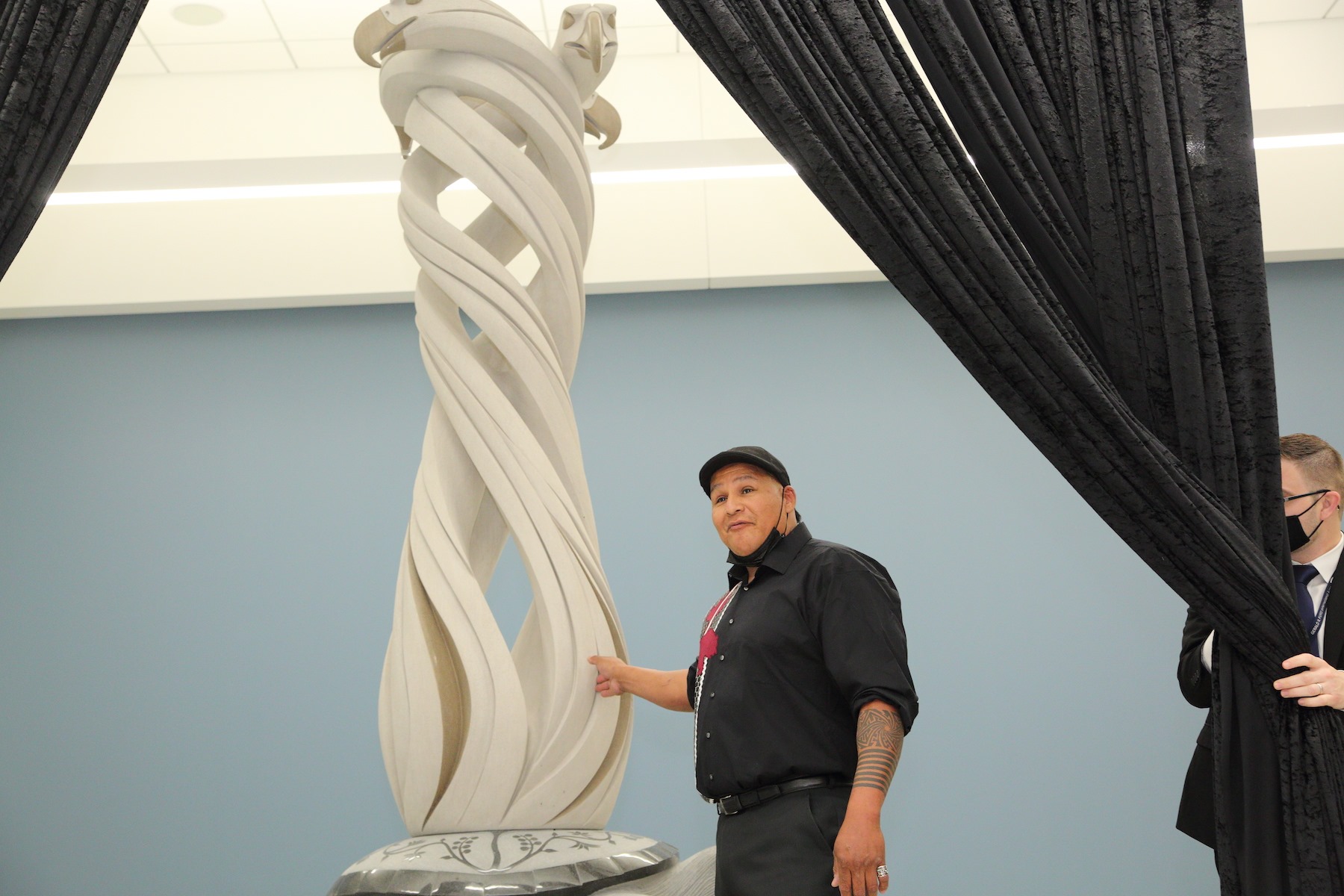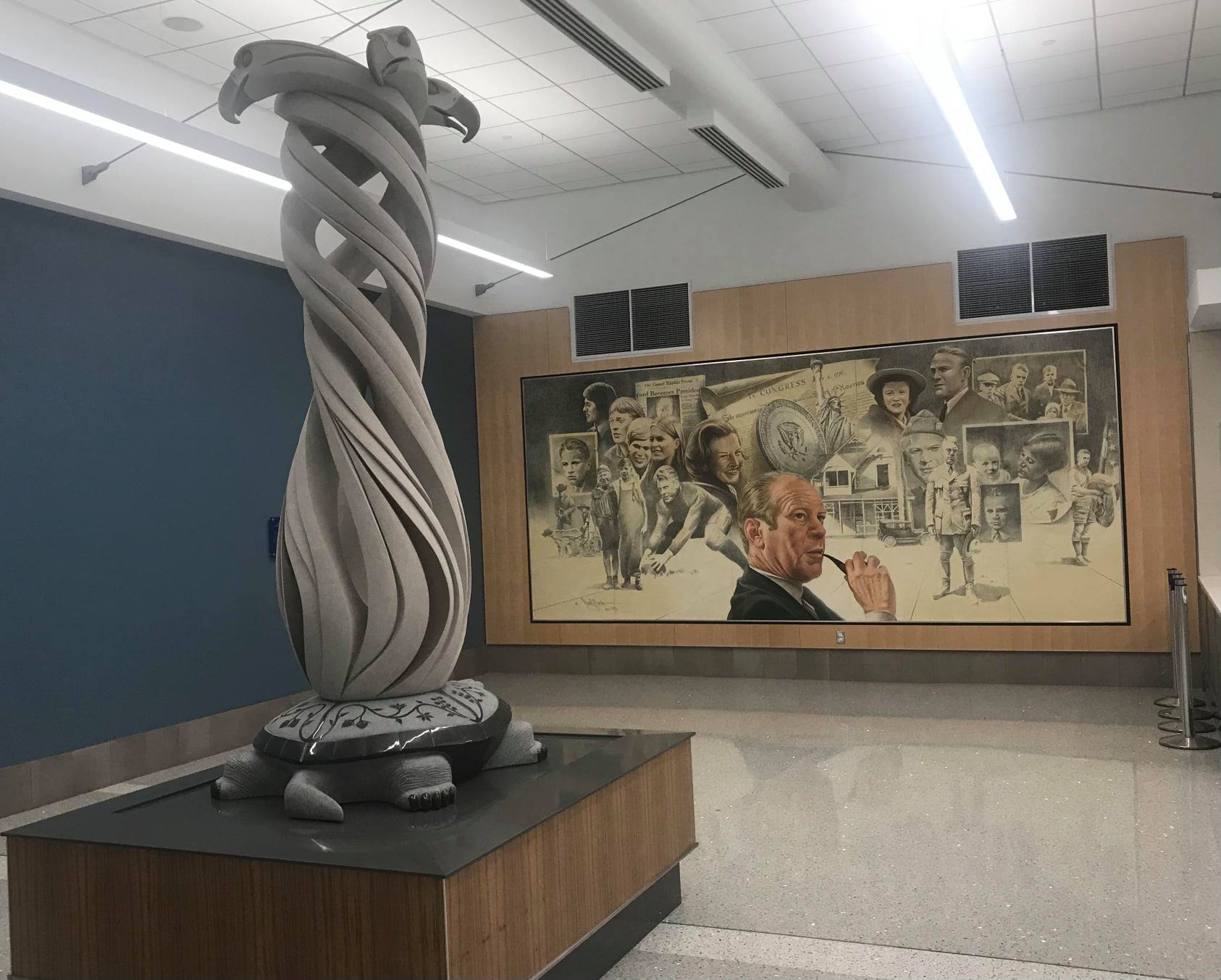
- Details
- By Levi Rickert
GRAND RAPIDS, Mich. —Travelers in and out of the Gerald R. Ford International Airport, West Michigan’s largest airport, now have an opportunity to understand the rich connection the region has to its Native population, which has its roots in Michigan for thousands of years.
On Wednesday, airport officials unveiled the 9-ft. tall “Aankobiisinging Eshki-kakamigak,” or “Connection to Creation,” carved sculpture that was formed from black granite and Indiana limestone and features important elements in Anishinaabe teachings. The sculpture was carved by award-winning Anishinaabe sculptor Jason Quigno.
“One of my purposes in life as an Anishinaabe man and sculptor is to honor my ancestors,” Quigno said. “My intention is to share a portion of the Anishinaabek’s beautiful history, our stories and rich traditions in stone.”

Quigno, a tribal citizen of the Saginaw Chippewa Indian Tribe, who has been carving stone since he was 14, is a life-long resident of Michigan and is a direct descendant of Chief Cobmoosa, also known as the Great Walker, one of the most recognized nineteenth-century Grand River Ottawa leaders.
The sculpture contains a lot of Anishinaabe symbolism carved in majestic work of art.
Its base features a turtle with Anishinaabe floral design representing the four cardinal directions – north, or giwaydoonig, east, or wabunnoong, south, or zhawanoog, and west, or ningabeunoong.
On top of the turtle’s shell sits a second feature of fire and flames flowing upward in a spiral pattern suggesting smoke. The pinnacle features four eagles with their mouths slightly open.
Quigno uses his art to educate those unfamiliar with Native American culture. He further explained the various elements of his work and their significance in Anishinaabe culture.

“The turtle, or mizkeekay, and its shell represent the land we inhabit. She is the base the fire and flames sit upon,” he said. “Fire, or ishkoday, is important to the Anishinaabek – through the fire and smoke, our prayers flow up to the creator. Finally, the four eagles, or migiizis, represent and acknowledge the four cardinal directions. The eagles are said to carry those prayers to the creator.”
The sculpture is located near the entrance of the airport to the left of the Southwest Airlines ticket counter. The work was commissioned by the Airport’s art committee.
Quigno says this piece is a point of pride for Native Americans in the community.
“I made this for the Airport and its visitors, but also for my Anishanabe people, for them to feel proud,” Quigno explained. “One of their own is making a monument to honor them.”
The sculpture was installed at the airport on Earth Day. It was originally scheduled for November in time for Native American History Month but was postponed due to COVID-19 restrictions.
More Stories Like This
Watermark Art Center to Host “Minwaajimowinan — Good Stories” ExhibitionMuseums Alaska Awards More Than $200,000 to 12 Cultural Organizations Statewide
Zuni Youth Enrichment Project Takes Top Emerging Artist Apprentices to Phoenix for Artistic Exploration and Cultural Immersion
From Dishwasher to Award-Winning Chef: Laguna Pueblo's Josh Aragon Serves Up Albuquerque's Best Green Chile Stew
Rob Reiner's Final Work as Producer Appears to Address MMIP Crisis
Help us defend tribal sovereignty.
At Native News Online, our mission is rooted in telling the stories that strengthen sovereignty and uplift Indigenous voices — not just at year’s end, but every single day.
Because of your generosity last year, we were able to keep our reporters on the ground in tribal communities, at national gatherings and in the halls of Congress — covering the issues that matter most to Indian Country: sovereignty, culture, education, health and economic opportunity.
That support sustained us through a tough year in 2025. Now, as we look to the year ahead, we need your help right now to ensure warrior journalism remains strong — reporting that defends tribal sovereignty, amplifies Native truth, and holds power accountable.
 The stakes couldn't be higher. Your support keeps Native voices heard, Native stories told and Native sovereignty defended.
The stakes couldn't be higher. Your support keeps Native voices heard, Native stories told and Native sovereignty defended.
Stand with Warrior Journalism today.
Levi Rickert (Potawatomi), Editor & Publisher

